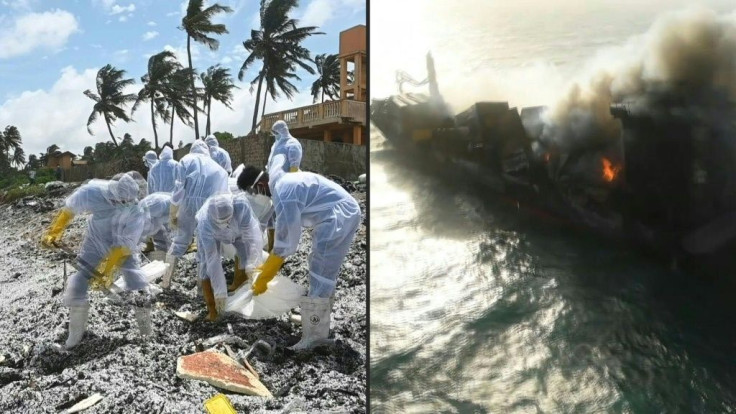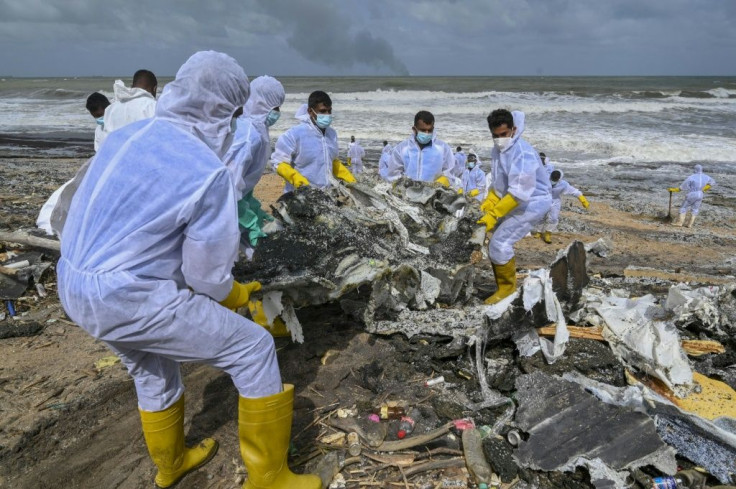Sri Lanka Battles Waves Of Plastic Waste From Burning Ship
Tonnes of plastic pellets from a burning container ship swamped Sri Lanka's west coast Friday, sparking a ban on fishing as international efforts to salvage the vessel dragged into a ninth day.
The government declared an 80-kilometre (50-mile) coastal area off limits for fishermen fearing contamination with pollutants and plastic waste from the stricken ship. The ban included Colombo's seafront too.
"We will compensate the owners of 5,600 boats affected by the ban," fisheries minister Kanchana Wijesekera said while adding that seafood currently in the market was safe for consumption.

The country's Roman Catholic church said most of the affected fishermen were their parishioners and urged Colombo to secure compensation from the ship's insurers for the loss of livelihoods.
Millions of plastic granules washed up at the holiday resort of Kalutara -- 43 kilometres south of Colombo -- on Friday, a day after similar pollution at Negombo, a tourist and fishing area 40 kilometres north of the capital.
Sri Lankan authorities meanwhile deployed thousands of security personnel in hazmat suits to clean the beaches of plastic waste and other debris from the Singapore-registered MV X-Press Pearl burning since May 20.

Sri Lanka navy chief Vice Admiral Nishantha Ulugetenne said the fire was largely under control and the risk of the vessel breaking up had diminished.
"Right now there is no threat of the ship breaking up, but we don't know how much of oil is still left," Ulugetenne told reporters in Colombo.

Sri Lanka's Marine Environment Protection Authority (MEPA) said a possible oil leak was the biggest threat, but the ship's plastic cargo had already caused extensive damage.
The impact on mangroves and lagoons was still being estimated while a beach clean up was already underway. Harm to marine wildlife and birds is also being assessed.

"Sri Lanka is one of the best bio-diverse countries in Asia and this type of plastic pollution, especially from microplastics can have long term repercussions," MEPA chairperson Dharshani Lahandapura said.
"Microplastics are already an issue in the world's oceans and this disaster here is making it worse for us."
Microplastics are very small pieces of any type of plastic less than five millimetres and could be ingested by fish and in turn get into humans.
She said much of the cargo, including 25 tonnes of nitric acid, sodium hydroxide (caustic soda), lubricants and other chemicals appeared to have been destroyed in the huge fire.
The X-Press Pearl, which is anchored just outside the Colombo harbour, was still smouldering and an international salvage effort to put out the fire was underway.
The fire broke out as the ship waited to enter the Colombo port. Authorities believe the fire was caused by a nitric acid leak which the crew had been aware of since May 11.
The 25-member crew evacuated on Tuesday and two of them suffered minor injuries in the process, the owners of the vessel said on Thursday.
Four Indian vessels have joined Sri Lanka's navy in the battle to contain the fire. Two of the vessels were also equipped to deal with an oil slick, officials said.
Indian coastguard aircraft also carried out reconnaissance in the area and reported that there were no signs of an oil slick.
Drone footage released by Sri Lanka's airforce Friday showed the fire confined to the rear of the vessel while black smoke continued from the three-month-old ship made in China.
Salvage operations are led by the Dutch company SMIT which has sent specialist fire fighting tugs.
The fire on the New Diamond tanker took more than a week to put out and left a 40-kilometre (25-mile) long oil spill. Sri Lanka has demanded the owners pay a $17 million clean-up bill.
© Copyright AFP 2024. All rights reserved.




















